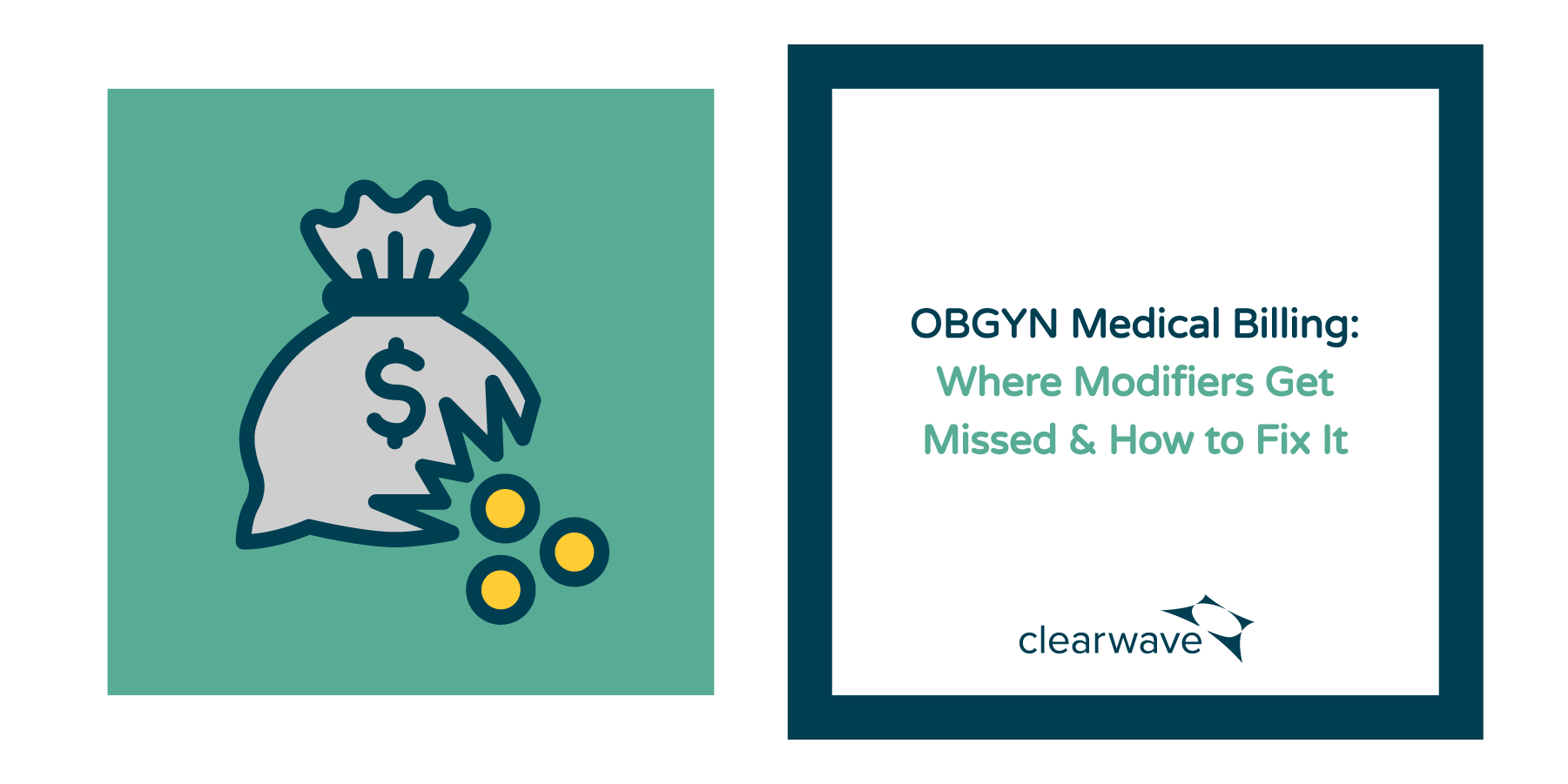OBGYN Medical Billing: Where Modifiers Get Missed & How to Fix It

By Chloe from Clearwave | May 1, 2023
Medical billing can be a complicated process, and when it comes to obstetrics and gynecology (OBGYN) billing, the process is increasingly extended and challenging. One of the common issues that OBGYN medical billing professionals face is the misuse or omission of modifiers, most often due to the global period of care. Modifiers are used to clarify services provided, beyond the standard of care for specific appointments. When modifiers are not used correctly or missed, it can lead to payment delays, revenue loss, denied claims or even compliance issues. See how modifiers get missed in OBGYN medical billing and how to fix it!
OBGYN Medical Billing and Modifiers
Modifiers are essentially used to provide more specific details about a medical service or procedure performed, which can have a significant impact on the amount of reimbursement received by healthcare providers. When physicians provide care, that’s revenue that they’ve earned. Modifiers ensure they earn it.
Modifiers are designed to provide a more detailed picture of the procedure or service, which can help insurance companies determine the appropriate amount to reimburse the healthcare provider. In the case of OBGYN medical billing, modifiers are even more crucial because OBGYN services often involve a series of related procedures over an extended period of time that fall into the global period of care. The most common global period of care they provide is through pregnancy care, delivery and post-delivery services. While a patient is often not billed until after delivery, modifiers can help practices earn revenue for any services that fall outside of that standard of care.
Without proper use of modifiers, insurance companies may not fully understand the complexity of the services provided and may deny or underpay claims, leading to significant revenue loss for healthcare providers. There are several common modifiers used in OBGYN medical billing. For example, certain modifiers can indicate a significant, separately identifiable evaluation and management service, on the same day as a procedure or other service. This type of modifier is important because insurance companies may otherwise assume that the service is included in the procedure or service provided, resulting in underpayment or denial of the claim.
Without the use of modifiers, the details of a service or procedure may not be clear to insurance companies, which can lead to claims being denied or underpaid.
Reasons Why Modifiers Get Missed in OBGYN Medical Billing
There are several reasons why modifiers can get missed in OBGYN medical billing, leading to underpayments. One reason is the global period of care, which refers to the time period during which all related services for a particular procedure are included in one bundled payment.
During this time period, certain additional services performed related to the original procedure are not eligible for separate reimbursement. If the healthcare provider fails to properly use the appropriate modifier to indicate that an additional service is not related to global period of care procedures, physicians will lose out on earned revenue.
Your experienced billing staff own the responsibility of properly modifying claims, yet with a substantial workload, they may not be able to dedicate enough time to modify claims correctly. On a weekly basis, your billing staff may neglect to modify certain claims due to their workloads, at all, resulting in lost revenue. This burden may be intensified by other billing issues, such as managing claim rejections or fulfilling administrative responsibilities, which leaves little room to focus on modifying claims. Consequently, the workload pressure may cause billing staff to overlook or partially modify claims, resulting in revenue loss and employee churn.
Consequences of Missed Modifiers
When physicians perform services, they want to get paid for the services they provide. The consequences of missed modifiers in OBGYN medical billing impact your entire practice, from missed revenue to frustrated physicians and overworked administrative staff.
Physicians will be frustrated with administrative and billing staff if their services go unpaid as a result of staff not using modifiers. In OBGYN medical billing, missed modifiers can result in services being billed at a lower rate than they should be, leading to a reduction in overall revenue. Additionally, missed modifiers can result in billing errors and delays in payment, further exacerbating the problem.
To address this issue, it is important for OBGYN medical billing professionals to have a comprehensive understanding of the appropriate modifiers for each service and to ensure that they are included in billing submissions. This requires attention to detail and ongoing education and training to stay up to date with changes in billing codes and regulations. It also requires time, which is a major challenge for busy OBGYN practices, especially with understaffing and a small billing department.
Additionally, missed modifiers can increase the workload and costs for billing and coding staff who need to identify and correct errors, leading to delays in reimbursement and potential loss of revenue. Therefore, it is crucial for healthcare providers to ensure that proper modifiers are used in OBGYN medical billing to avoid these negative consequences.
Give your valuable billing staff more time to ensure that appropriate modifiers are included in billing submissions, providers can avoid revenue loss and frustration, and ultimately provide better care for their patients. Start with automation.
How to Fix Missed Modifiers in OBGYN Medical Billing
You could hire more certified coders or pay for staff training in medical coding, but there are other ways to set your practice up for success, without doubling full-time employee (FTE) costs or increasing staff workloads. Drive billing success, before modifiers even come into play.
A comprehensive patient revenue platform that offers a variety of digital tools can assist high-growth practices in automating manual administrative tasks and capturing patient data accurately. This adjustment can reduce rejections and other data issues, giving your back-office billing staff more time to focus on modifying claims correctly and enhancing their value to the practice. By using such solutions, practices can also secure revenue that is difficult to reach through traditional means.
Use a patient revenue platform to improve front-end data capture and reduce staff workloads, to give them more time to focus on high-value billing activities, like modifying claims. Here are a few ways a patient revenue platform can help:
Schedule Management:
By using a patient engagement platform, healthcare providers can automatically manage schedules and ensure that all appointments are accurately recorded, with minimal to no staff intervention
Insurance Verification:
With real-time insurance eligibility verification, healthcare providers can ensure that patients are covered for the services provided, which can help to prevent claim rejections and other challenges that increase billing workloads. Insurance verification is a time consuming task when owned by your administrative staff. Automate the process and give staff a way to clearly determine issues with patient insurance, so they can solve challenges fast, and before patients even arrive.
Additionally, automated and real-time insurance verification can help OBGYN practices ensure that their patients’ insurance is up-to-date and active, so when it comes time to bill at the end of the global period of care, that they have the right insurance. This improvement helps OBGYN practice reduce time spent resubmitting new claims or tracking down a patient’s new insurance.
Improving Data Accuracy:
Tools like self-service patient registration can help your practice improve data accuracy. By implementing a patient engagement platform that allows patients to self-register and verify their own information, healthcare providers can reduce errors and improve the accuracy of billing information. A patient revenue platform that automatically reconciles and updates patient data, without staff intervention. With cleaner data via automation and patient self-registration, practices can reduce claims rejections, removing one major roadblock off of your billing staff’s workload, giving them more time to modify complex claims. Use a proven solution to streamline collections and ensure the most accurate information is processed in claims, further reducing rejections. With this automation, you will set your billing team up for success before modifiers even come into play!
In addition to using a patient engagement platform, healthcare providers can also take other steps to fix missed modifiers in OBGYN medical billing. One way to do this is to establish clear lines of communication between healthcare providers and billing and coding staff. Consider regular meetings and discussions to ensure that all parties are on the same page.
Maximize Your OBGYN Practice’s Revenue Streams This Year
To ensure that your practice is maximizing reimbursements, it is important to establish a solid foundation that starts with every patient interaction. Free up your staff’s time to focus on more complex billing tasks by using digital solutions to automate manual administrative duties and improve patient data capture. By implementing an efficient patient registration strategy, your providers can prioritize patient needs while your experienced staff can generate revenue for all the care provided to patients.
Clearwave Core is designed specifically to address revenue leakage challenges and restore valuable time and revenue to your high-growth OBGYN practice. With the ability to reach all possible revenue streams and scale practice growth, Clearwave Core is the solution your practice needs to optimize its efficiency and profitability. Learn more about how it can benefit your practice today!
Recommended for you
Related Posts
New From Clearwave Innovation Lab: Appointment Manager
Reading Time: 3 minutes Advanced Tools, Effortless Use, Rapid Staff Productivity. By Blakely Roth | May 29, 2024 Clearwave’s latest innovation, Appointment Manager, is…
How to Fill Patient, Staff & Profit Gaps Without Over-Exerting Your Tech Stack
Reading Time: 4 minutes By Blakely Roth | May 15, 2024 High-growth practices need effective solutions to reduce staffing burdens, without raising costs. Practice…
Top 2 Trends Gastroenterology Practices Are Using to Boost Profits
Reading Time: 5 minutes By Chloe From Clearwave | May 6, 2024 As we navigate through 2024, gastroenterology practices find themselves at a critical…




